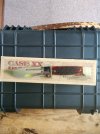A useful and interesting thread. Thanks to all but particularly
 Obsessed with Edges
Obsessed with Edges
One of the things I’ve encountered with buck 440c is the old timers told me that you had to file it before you could sharpen it on a stone. I tried it and it worked it seemed. Now I think I understand what was actually happening, I was breaking out some of the carbides and exposing more steel, which in turn would take an edge easier.
I have a question. When buck began using 440c stainless, where there no other choices? Did they use it because it was basically the only decent stainless for knife blades available?



